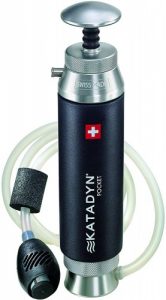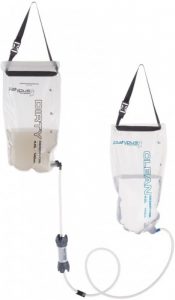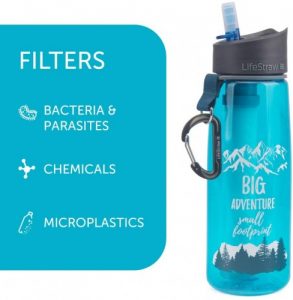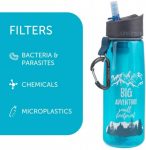Water is the most important element in the world.
Unfortunately, we take it for granted!
Having a personal water filter when you are out in nature is the most practical thing you can ensure.
You’ll always have clean and safe water to drink.
Here is the selection of the best portable water filters, essentials for every camper and backpacker out there.
LifeStraw Personal Water Filter

The LifeStraw is a personal filter that works in every outdoor scenario.
It has a 0.2-micron filter with a slow output.
The filter is designed to be used with a lot of force and sucking.
But, it will ensure you get 1.000 gallons of clean water before it needs replacement.
It is a bug-out bag essential and excellent for survival in nature.
The Product includes NSF, EPA and ASTM certification.
Also, the filter is compact and weighs only two ounces.
Pros
- Portable
- Lightweight
- Socially responsible brand
Cons
- Slow output
 Dylan's Take
Dylan's TakeNot only is the LifeStraw filter great for you, but the company is also socially responsible.
From every purchase, the company invests in providing clean water to children in different areas around the world.
Katadyn Pocket Microfilter

Katadyn filter is excellent for people who want a higher output, and don’t like the straw design.
It is suitable for two to four-person camping adventures.
Katadyn filter is a pump-activated filter that gives you one liter of clean water per every minute of pumping.
It is easy to maintain this system, and it will last you a long time.
Pros
- Suitable for constant use
- Durable construction made from ceramic and metal
- Fast operation
Cons
- Carbon cartridge is sold separately
 Dylan's Take
Dylan's TakeOverall, the Katadyn filter is bulkier than the LifeStraw system, but it is better suited for families.
It doesn’t require a lot of manual work and it has a sleek steel design.
Platypus GravityWorks

Platypus is a practical solution that keeps you safe and equipped with clean water in emergencies.
The system utilizes gravity to ensure clean water.
All you have to is fill the marked bag with dirty water and hang it on a higher point than the clean water bag.
The bags are color-coded and come with straps to hoist them up.
The filter is located in the center of the hose.
The low-micron filter removes 99.9999% of waterborne bacteria and protozoa, but you can boil water to remove other contaminants.
The Platypus filter is EPA and NSF certified.
Pros
- High capacity
- The labor-free water filtration system
- Easy to set up
Cons
- The buckle closure is plastic
 Dylan's Take
Dylan's TakeMy only complaint about this simple water cleaning system is the weak plastic buckle closure.
After two and a half minutes you can get an impressive four liters of water!
LifeStraw Go Water Bottle

LifeStraw is a trusted brand and this Go Bottle product is potentially the best solution for hikers who don’t stay long in one place.
The system works perfectly with a two-stage carbon filter.
It doesn’t leave black fleck or a nasty taste in the water.
Carbon filtration is an inexpensive and effective way to clean water.
One bottle has the capacity of twenty-two ounces.
The plastic ring under the cap has a nylon loop with a metal hook, to ensure durability.
The unit is BPA-free and EPA-certified.
Pros
- High capacity
- No manual labor required
- Easy operation
Cons
- The straps have weak closure
 Dylan's Take
Dylan's TakeThis bottle filter is a quite practical and easy solution for solo campers and hikers.
It is easy to pack and fits in the backpack drink compartments.
Grayl Ultralight Water Filtration Bottle

The Grayl is a new filtration option on the market.
It uses a three-stage filtration system based on ceramic fiber, ion exchange and carbon filtration.
The Grayl ensures that water is 99.9999% free of waterborne viruses, protozoa and bacteria.
Compared to the previous model, the Grayl lasts significantly shorter.
It makes it more expensive than some other options on the list, but the system has some great features as well.
In 15 seconds you can get two fluid cups of water.
Also, Grayl is a socially responsible brand, and it donates 1% of each purchase to environmental projects.
Pros
- Easy to use
- Socially responsible brand
- Can be used anywhere, anytime
Cons
- Short lifespan
- Low output
 Dylan's Take
Dylan's TakeThe Grayl bottle filtration is easy to use – fill it, push it down and enjoy clean drinking water.
It is easy to carry on your hiking trips, but it is on the high-end side.
Buying Guide
When you are choosing your portable water filter, the efficiency beats aesthetics.
But, there are more factors you need to consider when choosing the best water filter for your outdoor adventures.
Let’s dive into the details!
Size
The size of a filter determines portability.
If you are packing light you need something compact.
Luckily, the majority of portable filters are designed to be as compact as possible.
Type
There are different filtering systems – straw, gravity and pump.
The most effective is a gravity-fed system, but a straw-based system works better for bug-out bags.
Straw-Based
Straw-based filters take a lot of force and suction, and you have to ingest the water directly through a straw.
They are great for survival situations.
Gravity-Fed
These are suitable for people that need a high volume of water.
Gravity-fed filter features separate compartments for dirty and clean water.
These can provide one liter of water per minute.
The downsides are frequent cleaning and tubing replacement.
Pump-Activated
These filters require manual labor.
Run water through a carbon filter, and the process is simple, yet effective.
Output
The output of a water filter tells you how much water you can clean until you need to replace it.
For example, a LifeStraw can keep you covered for five years if you use it every single day.
Therefore, consider the maximum output, but most of the available filters have great output rates.
Flow Rate
If every camper with you has a personal filter, then the flow rate is less likely to affect your decision.
High flow rates mean higher prices.
A high flow rate of a filter just gives you more purified water in a single-use.
Durability
If you plan to use a water filter often, durability is an important system.
Straw-based systems are sustainable and don’t have that many moving parts like pumps or gravity filters.
More moving parts mean more chances for them to break and malfunction.
Certification
The certifications such as EPA and Cosura tell you that filters are tested and accurate.
Sometimes filters have only one certification but aim for those with at least two.
Frequently Asked Questions about Water Filters
Let’s answer the most common questions about camping water filters.
If you have more questions, feel free to ask them in the comment section below.
Can a Water Filter Remove Viruses?
No, water filters cannot remove viruses.
A water filter is different from a water purifier.
Filter only removes chlorine, chemical, lead and mercury.
To kill bacteria and germs for the water, you need to boil it.
How Long Can Viruses Live in Water?
Viruses can live long in the water.
Waterborne viruses are especially dangerous.
For example, rotavirus, toroviruse and norovirus can survive up to three weeks in water.
Many factors determine whether the virus will survive in the water or not – temperatures, pH, organic matter, light, etc.
Can a Water Filter Remove Giardia?
A water filter cannot remove giardia from water, you have to boil the water to kill it.
Is Boiling the Same as Purifying?
Boiling water for some time can kill bacteria, viruses, protozoa and other pathogens.
But, when you are camping, it isn’t easy to boil water and achieve certain heat for a certain time.
To ensure that pathogens are killed, achieve a rolling boil for a minimum of two minutes.
You’ve got the best chances to get clean water if you boil the water and use a water filter.
How Often A Carbon Filter Needs Replacement?
You should replace the carbon filter every six to twelve months.
Even if you haven’t used the filter for weeks or months, maintain the schedule.
Bacteria can develop on the other end of the filter, which affects the water and contaminates it.
On average, one water filter can last for a year and support five people that are drinking half-gallon of water per entire year.
How to Tell if It is Time to Replace Filter?
If you didn’t keep track of the time when the water changes taste it is a sign that your filter is ready for replacement.
The water can get an earthy or metal taste.
It is better to switch filters too early than too late because you can risk disease and infections.
Rather, start counting the time from day one when you first used the filter.
Conclusion
What do you think about my list?
Having a personal water filter within a hand reach is one of the first things you learn when starting your outdoor adventures.
Gravity, straw or pump-activated types of filtration are all good but designed for different purposes.
Straw-system is more for personal, pump and gravity are suitable better suited for family use!
Best Overall Choice
LifeStraw Personal Water Filter
We're a team of professional travelers, on-the-go freelancers, web producers, writers and editors. Our mission is to pick the best travel gear by analyzing customer opinions and writing our own findings to help you find the right products for you. Please share our posts to help us grow. Read more...







